Mon 20 May 2013
A TV Series Review by Michael Shonk: KING OF DIAMONDS (1961-62).
Posted by Steve under Reviews , TV mysteries[19] Comments
KING OF DIAMONDS. Syndicated, 1961-1962; Ziv/United Artists. Cast: Broderick Crawford as John King and Ray Hamilton as Casey.
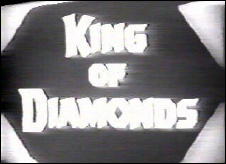
John King was the chief investigator for the Continental Diamond Industries. With Casey, his young handsome assistant, King led the fight against the evil IDB, the Illicit Diamond Buyers (well, at least the criminals were honest about it). Or as King explained, “… from the minute the diamonds come out of the clay until they go on somebody’s finger we protect them. The we is me.â€
King of Diamonds was a typical Ziv first run TV Film syndication series with the creative talent working against the limitations of low budgets and too short a production schedule. The series fortunately didn’t take itself too seriously which gives it a charm and makes it still fun to watch.
The pace of the half hour episodes were fast enough for us to enjoy the story without noticing or caring about the plot holes. The writing featured dialog that was equally quick:
“He grew.â€
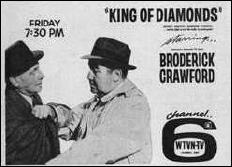
The episodes began with the narrator (probably Highway Patrol narrator Art Gilmore) setting up the story such as in “The Wizard of Iceâ€:
Broderick Crawford was the perfect Johnny King, tough guy detective, a man obsessed with the recovery of stolen diamonds. Murder, justice, those were the police’s problems all Johnny King wanted was the diamonds back. Crawford biggest acting challenge was trying to be convincing as a ladies man with beautiful women from his past still helpless against his charms.
It is hard to take the show seriously when King wore a trench coat and fedora in nearly every scene including at least once when he was sitting behind his office desk. Check out that outfit in this trailer for the series:
Ray Hamilton was forgettable in the stock character role of King’s young assistant. The guest cast was above average especially (in the episodes I have seen) Lola Albright, John Anderson and Gerald Mohr.
Directors such as Irving Lerner were able to overcome a lack of time and money and occasionally shoot some quality scenes such as a car chase in a high-rise parking lot involving three people in “The Wizard of Ice.â€
EPISODE INDEX. (I have watched three episodes each with incomplete credits. Titles from IMdb.com.)
“The Wizard of Ice.†Written and produced by John Robinson. Directed by Irving Lerner. GUEST CAST: Lola Albright, Telly Savalas, John Anderson, John Marley, and Richard Kiel. *** A hijacking of two million in diamonds gets complicated by a woman.
“Commando Tactics.†Written by Steve Fisher. Directed by John Rich. GUEST CAST: Gerald Mohr *** King’s fun loving WWII commando buddy has decided to try the adventurous fun life of a diamond thief.
“Backlash.†Written by Edward J. Lasko. Directed by Skip Homeier. GUEST CAST: James Coburn and Nancy Kulp. *** War hero and respected citizen in a small town in Maine has his past come back to haunt him as a former army buddy arrives wanting to sell the diamonds they had stolen from the Nazis during the War.
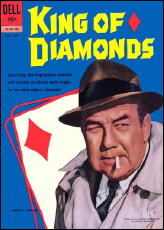
King of Diamonds was an entertaining show despite its flaws or in part because of them, but it was the story behind the scenes I found more interesting.
It is well known Broderick Crawford had a problem with alcohol (too many DWIs cost him his driver’s license and they had to adapt filming Highway Patrol). There is an interesting story about why Crawford agreed to do King of Diamonds in Rick Jason’s (The Case of the Dangerous Robin) autobiography Scrapbooks of My Mind. (Thanks to Wikipedia for citing its sources.)
“He’d dried out, hadn’t had a drink in almost nine months, and he wanted his money from Highway Patrol. Ziv cut a deal with him: if he’d do a pilot for a new series called King of Diamonds and sign on for the series, they’d release about two million dollars they were holding and he would only have to do one show a week if the pilot sold. He signed.â€
Despite being in over 185 markets including the top five markets in the country, King of Diamonds lasted just one season. TV was changing at the time. In the words of Broadcasting (9/18/61), “Production of programs for first-run syndication has virtually collapsed.â€
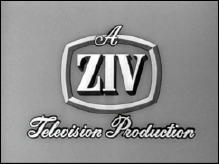
Production costs were rising. The trade magazine reported the cost of an average first-run syndicated TV Film series had risen to $40,000 to $50,000 per episodes. With a star such as Broderick Crawford (who was also credited as associate producer) King of Diamonds’ costs were most likely even higher.
Meanwhile the market had been taken over by off-network reruns that were cheaper, had proven popular with the viewers, and could be aired on a daily basis.
In the fall of 1961, King of Diamonds competed against twenty-one newly available off-network reruns series including Peter Gunn, Wanted: Dead or Alive, Hong Kong, Bat Masterson, Wyatt Earp, The Lone Ranger and Yancy Derringer.
Another problem facing first-run TV Film syndication was the increase in the networks’ involvement in the programs they aired. Even the weakest network, ABC had increased the amount of programs they scheduled and their series quality. Also, the hour-long format was beginning to take up more and more time of the prime-time schedule.
TV’s most successful first-run TV Film syndication company, Ziv Television would soon disappear as United Artists Television would completely take over the company (dropping the name Ziv from Ziv/United Artists television) in 1962 when Frederick Ziv sold the last part of the company he still owned and left Hollywood to teach at the University of Cincinnati.
It is hard to mourn the passing of Ziv Television with its bottom of the barrel production values, but it was responsible for a few shows such as King of Diamonds that might not have been the best television ever made, still have enough charm to entertain.
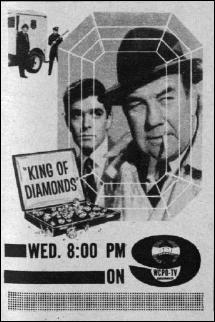
May 20th, 2013 at 9:37 pm
According to one iOffer seller, there are only the three episodes that Michael describes are known to exist.
Too bad. It sounds like a good show with some interesting guest stars who were (or who became) better known than usual.
May 20th, 2013 at 10:39 pm
I remember King Of Diamonds being broadcast and creating very little excitement while Highway Patrol lingers in the memory. Had King of Diamonds come first there probably would not have been a successful Highway Patrol. I thought from the get-go that no one cares about diamond theft at this level. Not about sharp jewel thieves and with a great but unromantic star. Probably could have brought him back as Chief of Detectives in a big city setting. Well, something like that. So, clearly all that Michael has written is so, but the series was tired from inception.
May 20th, 2013 at 11:49 pm
#2. Barry, they tried to make the series about the exciting intrigue of international crime. King traveled all over the world from Europe to Maine! Sadly, the evil, evillll organization of the IDB was no SPECTRE (Bond villains).
Oddly enough, a year before there was another pilot called KING OF DIAMONDS. Broadcasting (4/4/60) described it this way:
“New York diamond market is the setting for this CBS-TV packaged series, which Harry Tatleman will produce. Harold Medford wrote the pilot.”
May 21st, 2013 at 12:02 am
Michael,
That, about the earlier series seems interesting. Like to know a bit more. Was it shot and rejected or simply at the conceptual stage?
May 21st, 2013 at 9:51 am
And, in 1960-64, another factor helped slow first-run syndication…there weren’t yet enough independent commercial stations outside of the absolutely largest markets to give such programming a natural home outside the fewer and fewer holes in network primetime. It’s notable that these were last great active years for NTA, before it sold its Channel 13 in NYC to National Educational Television and became essentially a syndication partner of Fox (and then eventually the revival of Republic as the 1980s source of such neo-noir films as BOUND and FREEWAY).
May 21st, 2013 at 10:08 am
My favorite Ziv production of all time for sheer incredulity is still I Led 3 Lives, but judging from the trailer Michael includes above this has to be right up there. I think IDB might stand for Illicit Diamond Buyers rather than Illegal Diamond Buyers but either way they fact that they would advertise the transgressive nature of their behavior in their name is pretty much of a hoot, as is the theme song. Favorite line: “When Johnny King breaks a door down/He’s not saying 10-4 now/He’s romancing a queen.” Does that even make sense?
Variety reviewed this show on 10/11/61, describing Crawford’s King as “a tough, hard-driving cantankerous private eye” and saying the series “did him no service.” The reviewer seems offended that King, in trying to recover stolen diamonds, resorts to pulling the hair of a femme villain portrayed by Lola Albright.
Alas, no copies in the Paley Center library.
May 21st, 2013 at 10:32 am
#4. Barry, my guess is there was a script and plans to film the pilot for CBS network. The description used words such had written, will produce and CBS-TV (instead of syndication CBS Film). Lack of cast hints it was before filming.
This is the only place I have found any information about it. I wonder if Ziv knew about it. Ziv’s KOD was available to buy as early as April 1961.
One of my favorite annual issues of Broadcasting is the pilot for next fall schedule. In 1960s the system was evolving from advertiser produced series to network produced series. The article names three advertiser produced series slated for the fall General Foods’ ANDY GRIFFITH SHOW and ANGEL, and Procter & Gamble’s PETER LOVES MARY. There are also pilots from studios aimed at any network. There were some done for a network or syndication.
The article feels the need to explain what a pilot is. I wish I had a better link but this will get you started…
http://www.americanradiohistory.com/Broadcasting_Individual_Issues_Guide.htm
If that link works scroll down to issue 1960-04-04. Then scroll down to page 110.
May 21st, 2013 at 10:49 am
#5. You are right, Todd. Once the networks began to fill its schedules with programs it made more sense for small local stations to join a network. In my hometown of Pittsburg Kansas during this period we had two TV stations. One was CBS. The other was NBC and ABC. There was no financial reason for an independent station to exist.
May 21st, 2013 at 11:16 am
#6. David, you are right. It should be the Illicit Diamond Buyers (STEVE: could the magical internet elves correct the post replacing Illegal with Illicit?)
The song you hear was not used in the actual episodes. The theme music you hear after the singer stops was used as the opening and closing theme. As for the lyrics, my guess it is referring to Broderick Crawford’s last Ziv series HIGHWAY PATROL (10-4 now) and as a King, his ladies would be a Queen.
May 21st, 2013 at 11:49 am
A few points here and there:
– Local independent stations were all but unknown in the very early days of TV.
Here in Chicago, all four networks were represented:
Channel 2: WBBM-CBS
Channel 5: WNBQ-NBC
Channel 7: WBKB-ABC
Channel 9: WGN-DuMont
… and a little later …
Channel 11: WTTW-Educational
It wasn’t until the mid-’60s that the FCC ended a freeze on UHF stations, so that independent stations started to crop up in other than outlyng fringe markets (such as Rockford IL and South Bend IN, which I knew about thanks to TV Guide).
And that was just a little too late to keep Ziv in the original programming biz.
– I think I mentioned King Of Diamonds and its wonderfully weird theme song back in michael’s collection of opening title sequences.
This time around I took a closer look at that promo (Art Gilmore’s voice is unmistakable), The faces I recognized:
Jesse White
Nehemiah Persoff
Elisha Cook
John Vivyan (Mr. Lucky)
Stu Erwin
Walter Burke
James Coburn
Audrey Dalton (I think)
I remember reading of one episode titled “Kato The Clown” about a deaf-mute jewel thief, played by William Gargan – his only acting appearance after losing his larynx to cancer (this one I’d definitely like to see).
Maybe not a “lost classic”, but some of these episodes might be worth one more look.
– PS to the last:
After the KOD stuff played one of the after-clips was a mashup of Highway Patrol clips with people who made early appearances there:
Joe Flynn as a vicious holdup man
Stuart Whitman and Guy Williams as patrolmen
Clint Eastwood as a clean-cut biker
Barbara Eden as a just-freed hostage
Ted Knight as a grandstanding reporter
… and a couple of others I just forgot …
Interestingly, THiS ran a Highway Patrol about a week back at an ungodly hour, and who do you think the bad lady was?
A young Jeanne Cooper, whose death was announced that day. She really was Young and Restless back then.
Stranger Than Truth!
I’ve run dry for the moment.
Back later.
May 21st, 2013 at 12:00 pm
#9. Michael. I’ve made the change!
May 21st, 2013 at 12:02 pm
Right after I hit Submit I saw #9.
I think I said this at the older post, but I do remember that the song was used on the closing credits.
King Of Diamonds aired in Chicago on a weeknight (can’t remember which one) at 9:30, just before the 10 o’clock news.
If Ch9 was running a movie that night that my dad wanted to see, he’d switch over just as KOD was ending, and we’d hear this stoopid song.
Thing was, Ch9 would always cut it off just when they got to the line ” … When Johnny King breaks a door down …”, and I never got to hear the end.
Until 50-odd years later, when somebody posted it on YouTube, and someone from another site provided a link to it.
So much for history.
May 21st, 2013 at 12:26 pm
#12. Mike, the three episodes I saw according to IMdb were episode 1, 2, and 22. In my copy there was no use of the music with lyrics, however, one had a title card for “trailer to be added.” The end credits had been edited and only one had a next episode preview (#1 for #2). While the end credits I saw were minus the lyrics and used the opening credits music, it is quite possible the song was added to very end if the show was short or commercial spots unsold or the song was just cut out of my copies.
I trust your memories and ears more than this incomplete copy.
May 21st, 2013 at 4:59 pm
13:
You should also trust your embedded video, on which “The Johnny King Theme”, credited to William Donati, plays out in all its lyrical glory over the Ziv credit crawl.
That’s what I heard on ch9 at about 9:58, just before the news on – I still can’t remember which night *darndarndarndarndarn*.
Why it doesn’t appear that way on the shows you’ve seen –
– who can know?
We’re talking about the truly “lost generation” of filmed TV; the only people who cared about these shows were the ones who actually watched them.
The ones who made them didn’t believe that they would have much, if any, future.
Were they ever wrong.
May 21st, 2013 at 6:04 pm
Can anyone read the name of the executive producer in the embedded clip?
#14. IMdb, among others sites, credit Frankie Ortega with writing the theme music. I wonder which theme music.
It also claims Jon Epstein was executive producer. Credit readers will recognize the name from many series in the 60s and 70s from RAT PATROLand FLYING NUN to COLUMBO and MCMILLAN AND WIFE. Apparently he did work for Ziv at one point. But I saw only Babe Whoever credit.
May 22nd, 2013 at 9:46 am
The facsimile signature on the KOD credits was that of “Babe” Unger, who was something of a wheel at ZIV in its later days.
I don’t know much about him, outside of an anecdote told by Harlan Ellison about the latter’s scripting an episode of Ripcord.
An actress in the episode had mispronounced the name of the French novelist Camus; she said “CAY-muss” instead of “kuh-MEW”.
Harlan hit the roof, demanding that the scene be reshot or at least dubbed into accuracy.
He identified the man who shot him down in the screening room as “Babe” Unger, Ripcord‘s executive producer.
The details are in one of Harlan’s Glass Teat collections (can’t recall offhand which one).
As time moves on, I’ve come to realize that IMDb is more useful as a jumping off point thatn as an absolutely reliable source of info.
Many times, I’ve seen IMDb scramble credits for actors who have similar names (one example for many: Harry Dean Stanton is often mixed up with a much older actor named Harry Stanton in credits from the early ’60s).
They also aren’t adept at tracking multiple appearances in the same show by certain people; omissions and confusions abound.
Uncredited bit parts by then-unknown actors still slip in under the radar, unnoticed by IMDb.
As far as its lists of episodes for series, these are hit-and-miss at best, particularly if the original shows aren’t readily available for viewing.
On and on, but you get the point.
I’m now going to make it to myself by going there and trying to suss out info about what we’re talking about here.
Later …
May 22nd, 2013 at 10:02 am
Michael in one of his comments mentions a tv series called ANGEL I remember that sitcom for one episode. It starred Marshall Thompson who is married to a French girl named Angel. The episode had Thompson’s best friend talking him into buying 1000 shares into a company called Icobard Broadcast Mining. Total investment $100. The wives overhear them talking and look up IBM in the paper and see that it sells for $5 a share and think that they have invested $5000 apiece. Would that everyone had invested in IBM at $5 a share in the early 60’s.
May 22nd, 2013 at 10:29 am
#16. Thanks, Mike. Any researcher has his or her horror stories dealing with “facts,” be it from an ineptly written book to internet databases. Wikipedia ability to be wrong grows with your knowledge of the subject, but when it cites its sources it is the perfect starting point. Since I take the credits from watching the episodes, I use IMdb for episodes dates and titles. I then try to confirm those dates and titles at TV Tango where I sometimes find what aired opposite of the program I am reviewing. Billboard is useful for TV during the fifties but less so in the sixties and after. Google book is a useful source for stories about the people involved and behind the scenes of the program. Broadcasting is focused on the business of television and if I am lucky gives me ratings, reviews, and news of the time. Variety is on line but I am not spending $600 a year to get it. Los Angeles “Times” has been but google newspaper search is too difficult to navigate and may disappear soon. I am not interested in non-Los Angeles newspapers such as the NY “Times” since those focuses on reviews not news.
Libraries remain the best source, if you are lucky enough to live near one to specialize in your subject of interest. I need to start using the e-section of most of today’s library since getting around is difficult for me (I am allergic to gravity – my blood pressure falls dangerous low the longer I stand up – this forces me to sit (aww, poor baby). When I was in Los Angeles I never had the time to play researcher, and now I have the time I am not in L.A. (but instead LA. – Louisiana).
May 22nd, 2013 at 10:43 am
#17. Ray, there are several ANGEL full episodes on YouTube. Here is a link to one with James Garner as guest star.
https://www.youtube.com/watch?v=5HXJPEmZUYg